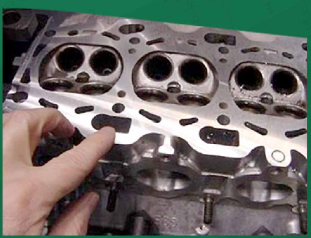

Repair sleeves are available with semi-finished I.D. that can be rebored to match the original finished parent bore.
Sleeve Qualification: Measure the sleeve 0.D., Top, Middle, and Bottom, rotate the sleeve 90 degrees, and measure again. The average measurement is the size of the sleeve.
Tips: The bore and sleeve should be as round and straight as possible. The surface finish inside the bore should be comparable to the 0.D. of the cylinder sleeve. A bore finish that is too aggressive may give a false indication of the true bore diameter as your bore gauge will be measuring the top of the peaks that are going to be displaced while pressing the sleeve in.
Press Fit Recommendations: Please note that the maximum interference is listed, but it is advisable to target one-half of the maximum interference recommended as a standard practice.
For Example: 2.00″ Bore up to 5-1/8″ = .003″ Press Maximum Target .0075″ (.038 mm) interference


A multi layered steel gasket requires a flat surface with a proper finish. Improper sealing will result from having the incorrect surface finish.
A profilometer, a device which allows you to measure the roughness of a surface, can be used to verify the surface finish. However, a simple finger nail test will do.
Drag your fingernail over the surface of your cylinder head. Your fingernail should not catch into a groove. There should be no visible cutting marks or metal bead-over from a dull cutter. The smoother the surface, the better the initial cold seal of the gasket and the less likely you are to have problems with coolant and combustion leaks. Most gasket manufacturers do not specify a minimum smoothness spec for aluminum heads that have MLS head gaskets.
Ensure the surface is flat, clean, dry, and smooth. No additional sealant is needed. Applying a secondary sealant to a multi layered steel gasket will create more of a sealing problem compared to installing it by manufacturer specifications.

The ultimate goal when servicing diesel connecting rods is to ensure the full set of rods are straight, on size and of the correct length. They should be machined back to the original OEM specifications.
Honeable bushings are acceptable if no other connecting rod large end machining has been performed and is recommended to only hone the bushing inside diameter.
Boreable bushings are required if modification has been performed on the connecting rod large end. Since the rod center-to-center length has been modified, this measurement has to be re-established for the full set of rods.
Maintaining the rod center-to-center length is key to keep compression ratio and cylinder combustions temperatures uniform. The final step in either bushing use should be to install the piston pin and check the alignment of the piston pin to the large end of the connecting rod. Assembly of the connecting rod and piston in the cylinder block assembly will then give you the protrusion/recession specifications to compare with the OEM specifications.







